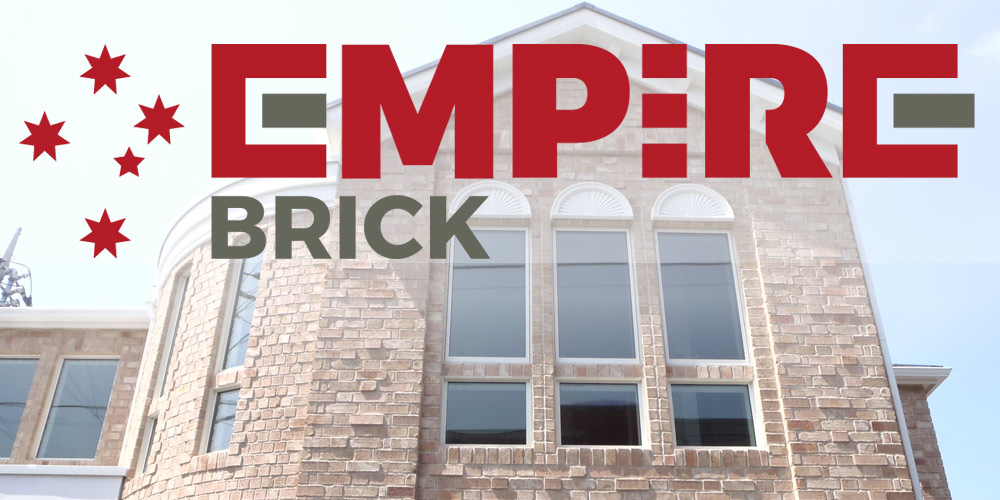
The 1980s were a turbulent and affluent time for the building industry in Australia, the perfect conditions for the development of EMPIRE Brick, a new lightweight brick facing system ideal for renovations, transportable buildings, and even new homes.
Home owners looking to capitalise on their assets were renovating existing properties at a rapid pace, and many were choosing traditional brick veneer. With tradesmen in short supply, lengthy project times, and council approvals, a family business with experience in vinyl cladding came up with a concept for ‘real brick’ cladding.

And after approaching Pat Slee – Sales & Marketing Manager at Austral Bricks for support, trials commenced and by 1984 EMPIRE Brick was a viable product.
Although there was still much to learn to efficiently cut brick facings at scale, and installation with the original Aluminium Rail system was challenging, the early years saw explosive growth throughout NSW, and by 1986 Pat Slee had resigned from Austral Bricks to focus solely on the marketing and installation of EMPIRE Brick. This time also marked a change in the Rail system, and a new galvanised steel system was introduced.
However, by 1994 and like for so many small businesses who experience rapid growth, there were problems with the original family management. Pat was asked by the Directors and Investors to take over the business and try to rescue it, but it was too far in trouble by that time.
Working with Jeremy Leather of Nowra Brickworks the business was re-established in Nowra with new ownership between both Pat and Jeremy, and by 1996 the remnants of the brick cutting business were acquired from the Liquidators.
With help from the Australian Government Trade Commission, visits to Japan led to the first ‘Australian Village’ in Gifu using EMPIRE Brick, and started a shift in focus to export markets. The Rail system was also to go through another transformation to make the system water resistant to better suit the Japanese market.
Factory locations moved a few times over the next decade including establishment in Queensland, and an association with QC Bricks in Bundaberg who provided purpose made bricks for cutting expanded the operation, but they have since stayed relatively consistent into the new millennium.
EMPIRE Brick Evolution:
1984 – Original EMPIRE Brick and Rail system is developed by a NSW small family business, with assistance from Austral Bricks. The first automated brick cutting machines are built, and the original single-course Aluminium Rail system is patented internationally. 20mm brick facings are used with grooves on both the top and bottom.
1986 – The Rail system is replaced by a 3-course galvanised steel sheet with ‘punched out’ lugs where brick facings simply ‘click’ into place. This new design increases installation efficiency and proves extremely successful for the home renovation market.
1989 – Newcastle earthquake provides a real-world performance test where 3 homes near the epicentre using EMPIRE Brick survive with no damage. Newcastle University performs extensive tests and EMPIRE Brick is rated to survive Mine Subsidence problems, Unstable Soils, and what will further be proved in Japan, both earthquakes and cyclones.
1996 – With a strong established export market in Japan, the Rail system is again modified to suit Japanese conditions by returning to a single-course design but removing the lugs (holes) to make the system more water resistant. With a continuous groove across the top of the rail, and no appreciable difference from the original system when using just one groove per each brick facing (top), this new design is established as the preferred mechanical fixing method which is still in use today. 25mm brick facings are also introduced to better comply with fire regulations in Japan.
2008 – The popularity of adhesive fixed brick facings explodes, and brick cutting is expanded to support brick facings (EMPIRE Click) from 20mm to 30mm. EMPIRE Slick Mortar Additive is developed to improve the mortaring process, and EMPIRE Brick Lips (brick spacers) are introduced to assist with adhesive based installation. Export has expanded to Taiwan, New Zealand, the South Pacific, and EMPIRE products have become a regular choice for shop fitting.
2016 – With bricks a trend for innovative design on large scale commercial projects, EMPIRE Brick is used in the prefabrication of panels and prefabricated brick homes built in factories and craned into position on site, creating new possibilities for efficient brickwork.
Despite management and ownership changes in the early years, EMPIRE Brick has a proven 30-year resilience to changing markets and conditions, with an adaptable product evolution that has sustained the business for decades.
With a thriving export business including Japan, a well-established shop fitting market clientele, and new projects in the commercial space, EMPIRE Brick is well positioned to continue to provide lightweight brickwork for many years to come.